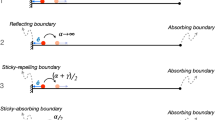Abstract
Mathematical models of the phenomena of the sorting out of embryonic cells are derived which predict multiple clustering of like cell types into many small islands. The experiments of Trinkaus and Lentz, and other essentially two-dimensional cell sorting results, provide examples. Two continuous models are introduced, both based on the Smoluchowski theory of Brownian motion. A mass-interaction model predicts local clumping of the internally segregating cell type within a continuum of the other type. A diffusion model simulates the suspension-aggregate experiments of Roth and Weston. A discrete model of sorting out, the exchange model, is re-derived in a clearer manner than before, and certain recent criticisms are responded to. Results in recent two-dimensional cell sorting experiments are discussed and a stability criterion for patterns of multiple clusters is introduced. The site frequency model is re-examined and criticized in terms of its application to the Roth-Weston experiments.
Similar content being viewed by others
Literature
Antonelli, P. L., T. D. Rogers and M. A. Willard. 1973. “Geometry and the Exchange Principle in Cell Aggregation Kinetics.”J. Theor. Biol.,41, 1–20.
—, D. I. McLaren, T. D. Rogers and M. A. Willard. 1975. “Pattern Reversal, Engulfment and Duality in Exchange Type Cell Aggregation Kinetics.”J. Theor. Biol.,49, 385–400.
Blumenson, L. E. 1976. Personal communication.
Chandrasakhar, S. 1943. “Stochastic Problems in Physics.”Rev. Mod. Phys.,15, 1–89.
Crank, J. 1956.Mathematics of Diffusion. London: Oxford University Press.
Davies, J. T. and E. K. Rideal. 1963.Interfacial Phenomena. New York: Academic Press.
Garrod, D. R. and M. S. Steinberg. 1973. “Tissue Specific Sorting Out in Two Dimensions in Relation to Contact Inhibition of Cell Movement.”Nature,244, No. 5418, 568–569.
Goel, N. S., R. D. Campbell, R. Gordon, R. Rosen, H. Martinez and M. Ycas. 1970. “Self-sorting of Isotropic Cells.”J. Theor. Biol.,28, 423–443.
Mayhew, E. and L. E. Blumenson. 1972. “Aggregation of Burkitt Lymphoma Cells in Stationary Culture: Experimental and Theoretical Analysis.”J. Cell Sci.,10, 749–758.
Mostow, G. D. 1975.Mathematical Models of Cell Rearrangement. New Haven: Yale University Press.
Middleton, C.A. 1973. InLocomotion of Tissue Cells. Amsterdam: Associated Scientific Publishers.
Middleton, C.A. 1975. To appear.
Parsegian, N. and D. Gingell. 1972. “Some Features of Physical Forces between Biological Membranes.”J. Adhesion,4, 283–306.
Rogers, T. D. and J. R. Sampson. 1976. “A Random Walk Model of Cellular Kinetics.” Accepted for publication inInt. J. Biomed. Comp.
Rosen, R. 1972.Foundations of Mathematical Biology, Cellular Systems, Vol. II. New York: Academic Press.
Roth, S. A. and J. A. Weston. 1967. “The Measurement of Intercellular Adhesion.”Proc. Natn. Acad. Sci., U.S.A.,58, 974–980.
Smoluchowski, M. V. 1927.Oeuvres. L'Acadamie Polonaise des Lettres.
Steinberg, M. S. 1962. “On the Mechanism of Tissue Reconstruction by Dissociated Cells—III. Free Energy Relations and the Reorganization of Fused, Heteronomic Tissue Fragments.”Proc. Natn. Acad. Sci., U.S.A.,48, 1769–1776.
— 1964. “The Problem of Adhesive Selectivity in Intercellular Interactions.” In M. Locke, ed.Cellular Membranes in Development. New York: Academic Press.
— 1975. “Adhesion-guided Multicellular Assembly: A Commentary on the Postulates, Real and Imagined, of the Differential Adhesion Hypothesis with Special Attention to Computer Simulations of Cell Sorting.”J. Theor. Biol.,55, 431–443.
Trinkaus, J. P. 1969.Cells into Organs. New York: Prentice Hall.
— and J. P. Lentz. 1964. “Direct Observation of Type Specific Segregation in Mixed Cell Aggregates.”Develop. Biol.,9, 115–136.
Trinkaus, J. P. 1975. Personal communication.
Van Emden, M. H. 1971.An Analysis of Complexity. Amsterdam: Mathematish Centrum.
Wiseman, L. L., M. S. Steinberg and H. M. Phillips. 1972. “Experimental Modulation of Intercellular Cohesiveness: Reversal of Tissue Assembly Patterns.”Develop. Biol.,28, 498–517.
Wax, N. 1964.Selected Papers on Noise and Stochastic Processes. New York: Dover Publications.
Author information
Authors and Affiliations
Rights and permissions
About this article
Cite this article
Rogers, T.D. Local models of cell aggregation kinetics. Bltn Mathcal Biology 39, 23–42 (1977). https://doi.org/10.1007/BF02460679
Received:
Revised:
Issue Date:
DOI: https://doi.org/10.1007/BF02460679




